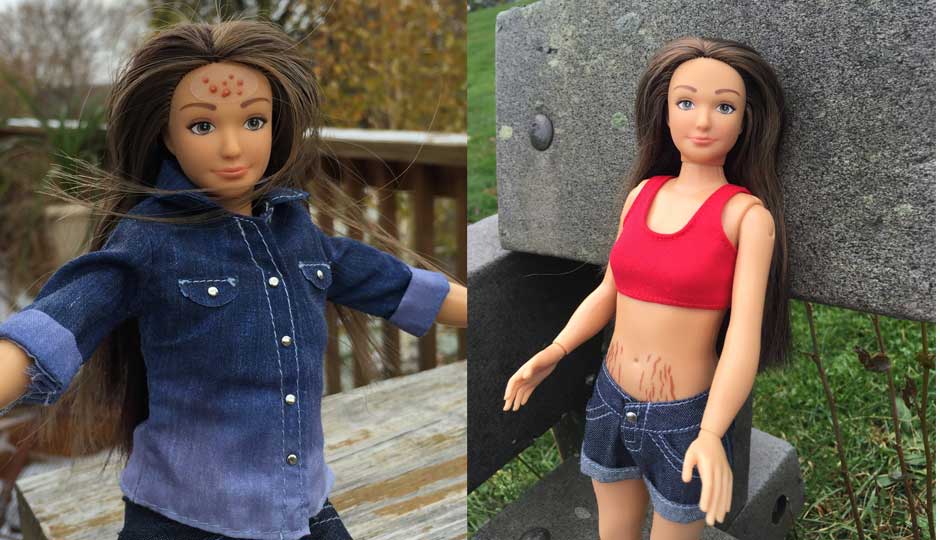Do We Really Need a “Normal” Barbie Doll With Acne, Scars, Cellulite and Tattoos?

Barbie’s latest accessories: acne and stretch marks. | Photos via Lammily.
Like millions of kids, I played with Barbies a lot. I sewed teensy clothes for them and spent hours dressing them (perhaps foreshadowing my future career?). I washed Barbie’s plastic hair in the tub which turned it into a syrupy mess and led to very scary doll haircuts, arranged her ant-sized shoes in color order (definitely foreshadowing my future OCD tendencies), decorated her Dream House, made her kiss Ken and scoffed at her little sister Skipper, whom everyone knows is a poor man’s Barbie.
And, like million of kids, I also developed a severe eating disorder which, 20 years later, still prickles at my thoughts on a daily basis. Dozens of psychiatrists, dieticians and therapists probed for the source of my eating disorder. It was my upbringing! My perfectionism! My genetics! My mother!
In any case, Barbie never came up in conversation.
People have been talking about the unrealistic portrayal of women’s bodies for decades. But nothing has really changed: Mannequins are still disproportionately thin, models are still waifish, Disney princesses still have waistlines smaller than their wrists, and Barbies still have a physically impossible ‘thigh gap’, a Google-able, hashtag-able term that thankfully didn’t exist back when I was in the thick of my disease, though the concept certainly did. That’s why, when posts about Nickolay Lamm’s “Normal Barbie” started taking over Facebook, I reacted the same way an underpaid employee reacts to a paltry Christmas bonus: Nice effort, man, but it’s just a drop in the bucket.
Lamm created “Normal Barbie” —which has the proportions of an average 19-year-old girl—earlier this year. Now he’s introduced accessories to the mix, tiny vinyl stickers you can plaster all over Barbie: acne, scars, stretch marks, cellulite, moles, tattoos. The thought behind the stickers and dolls is nice: “I feel like there’s a very good chance that those types of [unrealistically skinny] dolls affect young girls,” Lamm said in a March interview with Fast Company. But do kids really need a sucker-punch of reality every time they play with a doll?
Dolls are fantasy. I didn’t play with baby dolls because I actually wanted to experience the realities of parenting. And as a child, I was still blissfully unaware of things like stretch marks and cellulite. Even though I now have a hair-trigger response to comments or attitudes that could ignite body-image issues in others, I don’t think my seven-year-old self would have wanted to play with a Barbie doll that had stretch marks snaking up its stomach.
I don’t blame Barbie for my eating disorder. In fact, I place more blame on Victoria’s Secret catalogs, fashion magazines and blogs (yes, I realize the irony), which reinforce the very skinny, airbrushed, Photoshopped body as the ideal. But the real issue for me—and, I believe, for many of us who have suffered from anorexia or bulimia—isn’t societal pressures, but control. Playing with Barbies didn’t spur my need for control; if anything, it exposed its inauspicious beginnings in solider-like lines of tiny plastic shoes and perfectly organized Dream Houses.
Creating dolls with more realistic measurements is, of course, a step in the right direction. As Lamm said, if these “normal” dolls can prevent even a few children from developing eating disorders later in life, it’s worth it. (Of note: Far less people are wringing their hands over insanely chiseled male action figures. Sorry, skinny, pimply little boys: We’ll get to your issues later.) But, as cellulite stickers have shown us, it can also be a slippery slope. Pretty soon, we’ll see Dream Houses whittled down to mimic real life—a rent-controlled apartment for you, a tiny rancher for you (Yes, I know you can’t fit that doll bed in there but, kid, that’s reality, get used to it). And those red-and-yellow Little Tikes cars, they’ll come with squeaky brakes and a busted muffler.
Maybe we need to take a step back, and realize that body image issues go far deeper than a Barbie doll. And maybe, sometimes, the best thing we can do for our kids is to let them enjoy the fantasy—a world without cellulite—for a little bit longer. They’ll get stretch marks soon enough.
